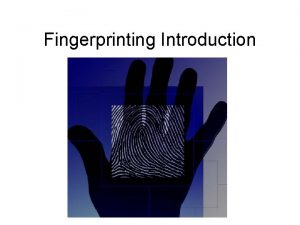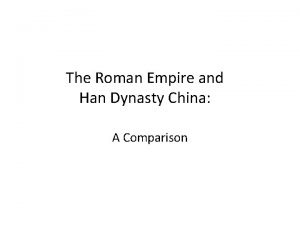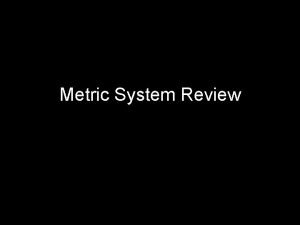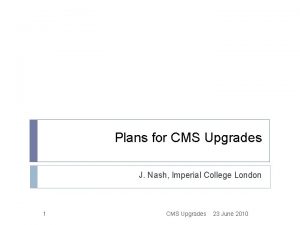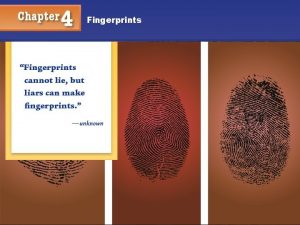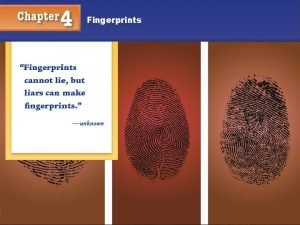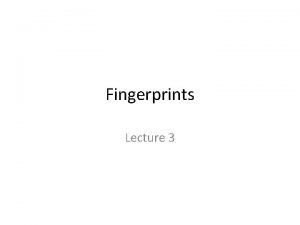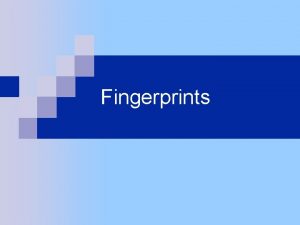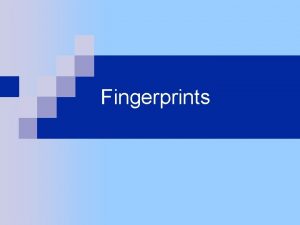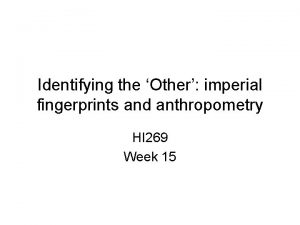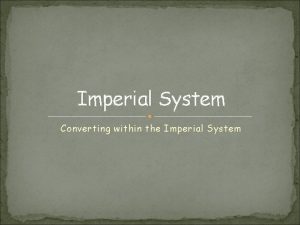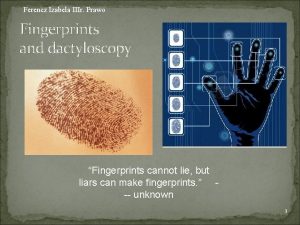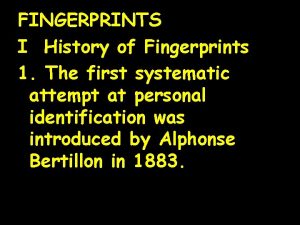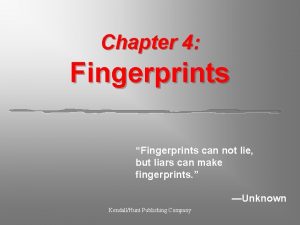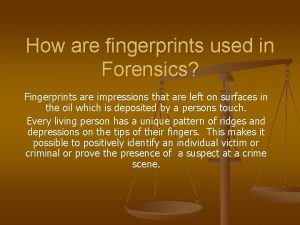Identifying the Other imperial fingerprints and the State

















- Slides: 17

Identifying the ‘Other’: imperial fingerprints and the State HI 269 Week 4

But first… A few reminders: 1. Students must get their first short essay titles approved by the end of Week 5, if they wish to write on a subject of their own choosing. 2. The first short essays are due 5 PM Thursday, Week 7, Term 1

Anthropometry • Literally, ‘the measurement of man’; • Like craniometry, anthropometry was closely associated with the new discipline of anthropology, and with the idea that measuring the body could reveal data about mental as well as physical aptitudes and traits; • In parallel, systems of anthropometric measurement were developed to identify individuals and ‘types’ (and thus to allow both reactive and pro-active identification of criminals). Among the most important of these systems was Bertillonage.

Anthropometry and Empire • As a mode of knowing and understanding subject populations, their needs, and their peculiarities • As a mode of identifying and thus controlling ‘homogenous’ and unrecognizable subject individuals

The People of India (London: India Museum, 1868)

Anthropometry and Empire • Empire/colonies as a test bed for practices later deployed in Europe • Broader societal interest in wake of Darwin and with rise of ‘social Darwinism’ and eugenics

Anthropometry and Empire • Increase in interest following ‘Sepoy Mutiny’ of 1857 • “such a survey will be a help to good government… instead of being a mere scientific luxury, as it might be in Europe, it was almost an administrative necessity in Bengal” Risley, 1891

Controlling India, identifying Indians • Desperate administrative need for conclusive forms of identification in relation to: – – Taxes Property ownership Business contracts Pension rights • Conviction that all Indians were inherently deceptive, whether for gain, or from a desire to please – and therefore indigenous testimony was totally untrustworthy

Identity for Empire Finger prints were regarded as especial value in ‘identifying persons of other races…’ Thus they were perfect for the colonies, where: ‘The natives are mostly unable to sign; their features are not readily distinguished by Europeans; and in too many cases they are characterised by a strange amount of litigiousness, wiliness and unveracity. ’ Galton, 1892

Chronology of fingerprint identification India • 1857 ‘Sepoy Mutiny’ • 1858 William James Herschel demands handprint as confirmatory ‘signature’ for a contract with an Indian • 1860 Indigo uprisings; Herschel suggests fingerprints as contractual signature for illiterate peasants and later planters • 1877 Herschel is able to institute fingerprinting for pensioners, deed registrations, prisoners • 1878 Faulds too notices fingerprints in Japan and begins collecting information • BUT: Govt of India did not adopt the practice and it had died out by 1890 s • 1891 -2 Edward Henry, IG Bengal Police introduces integrated anthropometry and fingerprinting (women excluded) • 1893 Herschel’s registry fingerprinting system reintroduced in Bengal for contracts, later pensions, postal orders, etc • 1897 dissatisfied with anthropometry Henry devises system for classifying fingerprints

“…We may classify human beings and human features but cannot bring about or find a precise agreement between any two; we have white men, red men and yellow men; we have well ascertained and defined types of humanity; we have in each type classifications of hair, eyes, noses, mouths and so on; but … a large residue of difference between any two individuals remains as it were a recurring decimal which cannot be distinguished; the difference between each human face and every other of its species. Upon which evidence of identity has been always so firmly rested can be easily observed, but it cannot be specifically and completely isolated. We know that it is there, but we cannot in any case completely define the details. But in the case of finger impressions, there is no question of dealing with those evanescent expressions which so largely contribute towards recognition of the identity of the human face. The exact differences in such impressions may be pointed out with as much certainty as the differences between the maps of two countries…” [Emperor vs Sahdeo - cited in K J Aiyer, Law and Practice of Evidence in Criminal Cases in India and Pakistan (Allahabad, 1949) p. 461.

Systems of Surveillance and national identities “ In Paris, every person arrested for any offence is at once subjected to the process of measurement and is sometimes photographed before being brought before any magistrate. It would not be consistent with English ideas to entrust to the police an arbitrary power of measuring or photographing every person arrested without authority from a magistrate and without regard to the necessity for the purposes of justice of discovering his antecedents and character. ’ Troup Committee, 1893

Systems of Surveillance and national identities “ In every country of Europe, I believe, even in countries like France and Italy living under democratic institutions, surveillance of a far more rigorous character [than in England] is permitted by the law” Northern India magistrate, circa 1893

Imperial Fingerprints • Why did fingerprinting emerge from India? • Why did colonial administrators, in particular, need to define individuals, and why did they choose a physical, embodied identifier as their preferred method of doing so? • What does this choice reveal about their assumptions about Indians, India, and themselves?

First DNA fingerprint case • Alec Jeffries and the Pitchfork murder case • 1977 -84 Jeffries works on technique to use RFLPs (restriction fragment length polymorphisms: highly individually variable isolated sections of DNA) to identify individuals. • 1986 Jeffries’ technique called in for Pitchfork case; rules out prime suspect. But how was the murdered caught – DNA evidence? No: he gave himself away when he asked a friend to give him a substitute blood sample… What does this tell us about public perceptions of forensic science, DNA etc?

• Is there such a thing as ‘mechanical objectivity’? (In other words, are photographs more objective than paintings or words? Are fingerprints more objective than bertillonage? ) • What are the differences between ‘salvage’ and ‘detective’ uses of photography?

Great Websites to explore • http: //ctl. ncsc. dni. us/biomet%20 web/BMIn dex. html • http: //www. nlm. nih. gov/visibleproofs/exhibi tion/views. html • http: //www. virtualmuseum. info/collections/t hemes/temple_man_tuson/html/andaman. html • http: //www. historycooperative. org/journals/ ahr/109. 2/rodriguez. html • http: //openlibrary. org/b/OL 23325034 M/peo ple_of_India
 What are the 3 fundamental principles of fingerprints?
What are the 3 fundamental principles of fingerprints? Adjective
Adjective Non identifying adjective clauses examples
Non identifying adjective clauses examples Identifying and non identifying adjective clauses
Identifying and non identifying adjective clauses Types of positions
Types of positions Imperial wars and colonial protest
Imperial wars and colonial protest Empire vs dynasty
Empire vs dynasty Imperial or metric
Imperial or metric Arch fingerprint
Arch fingerprint State graphs in software testing
State graphs in software testing Absorptive state and postabsorptive state
Absorptive state and postabsorptive state Absorptive state and postabsorptive state
Absorptive state and postabsorptive state Zczc state graph
Zczc state graph Countries that use imperial units
Countries that use imperial units Cms imperial
Cms imperial Metric units of measurement
Metric units of measurement Sensible units
Sensible units Chapter 30 section 3 imperial china collapses
Chapter 30 section 3 imperial china collapses
